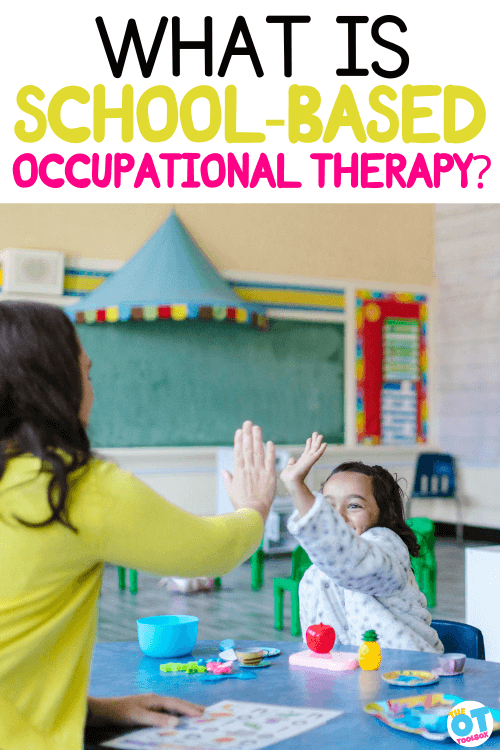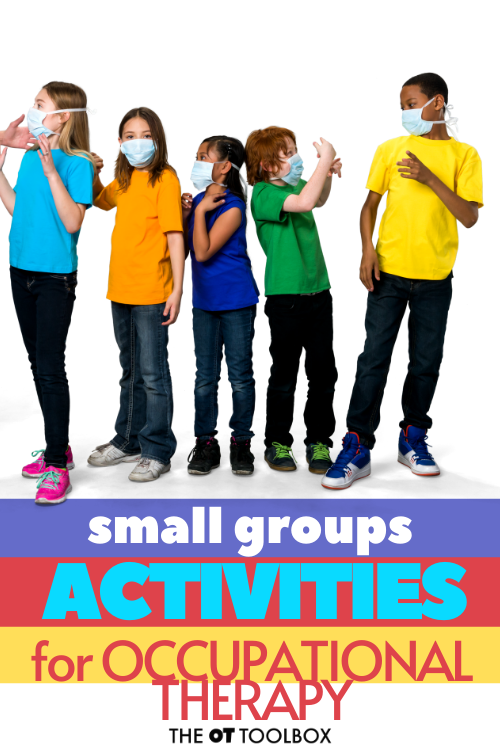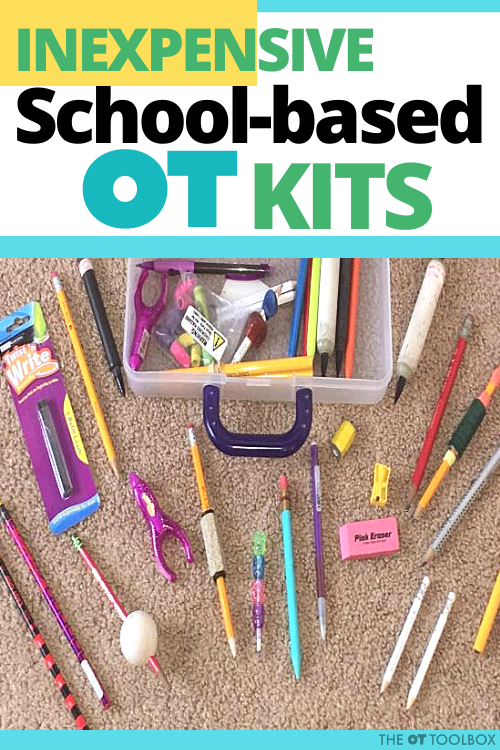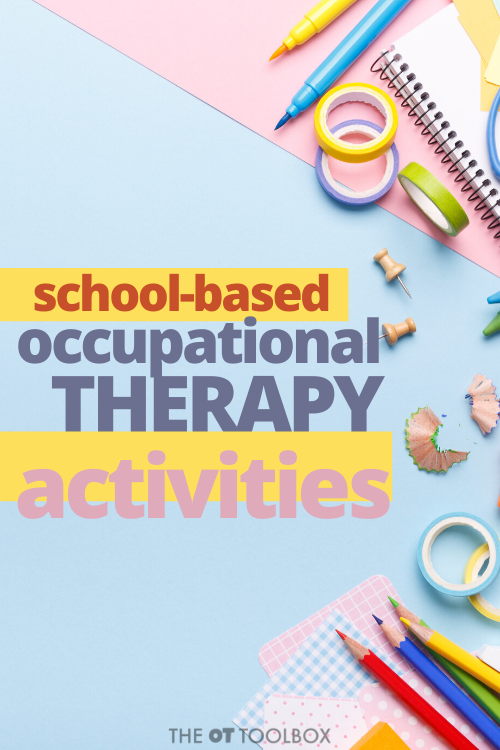Occupational therapy in schools looks a lot different than it has in the past. With social distancing requirements, sanitizing needs, and changes to school schedules, therapists are looking for ways to meet the needs of their students. This year, school-based OT looks different than any other year, and occupational therapy activities will reflect those changes.
Here, you will find strategies that school-based OT practitioners can use in the classroom as part of push-in services, in small groups, or in an individual, pull-out model.
What is school based Occupational Therapy?
One thing that I love about the profession of occupational therapy is that there are many environments and areas to cover. It’s all about the individual and the functional performance areas can be drastically different simply based on the environment.
In school based OT, occupational therapy providers support students in their education. We might support fine motor, visual motor visual perceptual, sensory motor, executive functioning skills, cognitive skills, physical skills or other area which impacts the student’s ability to learn.
School-based occupational therapy practitioners are either occupational therapists (OTs) or occupational therapy assistants (OTAs) who use meaningful activities
(occupations) to help children participate in the tasks they need to do in order to learn and participate in the school day. School based occupational therapy practitioners addresses the physical, cognitive, psychosocial and sensory components of performance which impacts learning.
This might look like supporting needs in academics, play at the playground or at recess, social participation, self-care skills (ADLs or Activities of Daily Living), and transition skills.
From targeting skills like executive functioning in schools to developing fine motor skills through play (ideal for the preschool occupational therapy interventions!), school based OT professionals do it all!
While OT in the medical model can cover similar areas in some ways (underlying developmental areas like fine motor skills and functional skills like self care or handwriting), there are big differences too.

What does a School Based OT do?
A school based OT can work on many different areas in the school environment. It will all depend areas the student struggles with in their education. Basically, if a student’s developmental challenges impact their ability to participate in their education, then OT may be involved to support these areas of need.
It all starts with an OT evaluation. Here is information on how to request an OT evaluation.
Depending on the needs of the student, a school based OT can address:
- Fine motor skills (impacting areas like holding a pencil, cutting with scissors, using school materials, managing clothing fasteners, manipulating materials like books and glue sticks, etc.)
- Gross motor skills (impacting areas like moving throughout the school, using playground equipment, walking in the hallway, etc.)
- Visual-motor integration
- Sensory processing- For example, here are ideas for using playground equipment to support sensory needs.
- Sensory Diet creation
- Coming up with sensory strategies in the classroom to meet needs
- Self-regulation
- Handwriting
- Self-care and daily living skills- for toileting, clothing fasteners, shoe tying, managing coats or jackets for leaving the school building, washing hands, etc.
- Feeding needs (in some cases)
- Social skills
- Play and leisure skills
- Executive functioning- including organizing materials, attention and focus, problem solving, planning and prioritizing projects, etc.
- Assistive technology use
- Environmental modifications- for example, supporting needs like getting on and off the toilet for physically involved students
- Mobility considerations- accessing areas of the school, bus, auditorium, cafeteria, hallways, etc.
- Transition skills
- Behavioral strategies
- Motor planning and coordination
- School participation and access
- Other areas
Then, knowing that these are all of the areas that a school based OT provider can address in the school environment, there are different roles the OT plays as well.
Roles of a School Based OT
The school based OT has many roles in the school system. AOTA has a resource on this which describes roles like: educator and trainer, resource consultant, advocate, leader, and researcher. These roles typically happen all day long as a school based OT!
When it comes to actually intervening with students, a school based OT can support students in various models:
- Direct OT Interventions
- Consultation
- Professional Development and Training
The typical school based OT will do all of these roles in a single day! Let’s cover each of these roles:
Direct OT Interventions
Direct treatment is done following the OT screen and evaluation, and completion of OT goals which are added to the student’s IEP. There will be a process which is followed, depending on the state requirements, which may include RTI, MTSS, etc.
Direct OT interventions can look like one on one therapy sessions, group OT sessions, or push-in therapy interventions. All of these models provide services to support at-risk students. The main thing to remember is that we always use the most appropriate intervention model to improve the academic outcomes and school conditions the individual student’s learning.
School Based OT Consultation
Consult refers to periodic “check ins” with educators that are involved with the student. The school based OT professional providing consult services will address specific needs and make recommendations that are carried out in the classroom. The consult process involves checking in with the teacher or teacher assistant on how the recommendations are being used and how it’s going.
For example, I’ve moved students from direct intervention into a consult model when the student has progressed to a certain point. I’ve used the consult model with students in middle school OT or high school OT who have had several years of direct interventions.
Another example of consultation is supporting teachers by setting up a calm down corner in the classroom. The teachers that I’ve worked with in this way have been very appreciative.
Professional development and training
This can be a tricky area of the school based OT provider’s job requirements, because if the OT provider is a contracted OT, time spent training and educating educators or other members of the staff may not be paid time. However, this time can roll into the consult model if specific and individualized training and education is provided. For example, in one situation, I ran a training to a group of educators and special educators on using the ALERT program with one student. The training session was individualized for the particular student and we went over recommendations for this one student that would be implemented into the classroom. We scheduled this time as a meeting and it was billed to the student because we were setting up the program for this one individual.
Another area of professional training is to support the entire school by setting up a sensory room. The school based OT professional is a valuable asset for the school in this regard.
Some admin will pay for this time in the way of a staff development training session. OT providers who are employed by the school district however, may have these requirements built into their contract. It’s just one more component of the school-based OT’s job description!
Group Occupational Therapy
Many OTs need to move from a push-in model to pulling each one of their students out of the classroom for therapy intervention. Other therapists will focus on pushing into the classroom for a small group activity with a couple of students who are in the same classroom.
Regardless of the model, occupational therapy activities will need to have social distancing practice in place and thoughtful use of supplies. Looking for group occupational therapy activities that can be completed with a small group?

Some recommendations for group OT can include:
Arranging the occupational therapy room so that students are well-spaced out. Using painters tape to create marked stations for each student can be used for social distancing, but also to help kids work on personal space, body awareness, and spatial awareness. Students can carry this skills over to functional tasks such as standing in lines in the hallway or getting on/off the school bus, or in the community.
Sensory coping strategies in the classroom can be adjusted to address social distancing requirements while meeting the child’s needs. Think about Simon Says, wall push-ups, I Spy games, etc. These therapy Simon Says commands can target many different skills through play.
Brain breaks can be used on an individual basis, in small groups, or in the whole classroom.
Mindfulness activities can be implemented in therapy sessions or in small groups.
Pushing into the classroom to work with a small group might be something that some therapists have to do per school recommendations and wishes. When pushing in to the classroom, precautions can be taken to try a group activity without close interaction like “I Spy” or “What’s missing?” visual perception games. Add handwriting to these group activities to work on specific skills, too.
There are points for both push-in service and pull out model of school occupational therapy during a pandemic. For example, pushing into the classroom or using a consultation model can mean less equipment that needs to be sanitized between sessions.
School Occupational Therapy Tips
These suggestions can be used by school-based OT professionals in pull-out sessions or in push-in therapy in the classroom.
Plan ahead. Use this interactive school-based OT planner to plan out activities based on themes and come up with a plan for each week. This can help with accessing materials and using what student’s have in their desks to work on certain skills. (See below for how to use what the student has in their desk.)
Organize the OT space so that items can not be accessed by students. Keeping items out of reach of students will allow for less sanitation time between sessions.
Pull out items that will only be used during that session and place each used item into a designated bin or “sanitize zone”. These items can be sanitized after each session and allowed to dry after the use of sanitizer.
Washing hands before/after each session. When children come into the occupational therapy space as a small group, or when a small group is seen in push-in services, therapists can have each child wash and dry their hands or use hand sanitizer both before and after each session. Make it part of functional goals, if it is something that can be used to meet the goals of the child. Hand-washing offers opportunities to work on eye-hand coordination, fine motor skills, tactile sensory experience, attention, organization, motor planning, and more…all part of a functional activity of daily living. Add in the clean-up portion (throwing away paper towels) and you’ve got aspects of IADL work as well.
Allow time for washing hands/sanitizing. we know that as therapists, we have a FULL schedule. Some OT professionals juggle 60+ students and many different school districts. But, allowing time for sanitizing and hygiene is a must. It’s not going to be easy, but like everything else, we are going to be forced to slow down and take that necessary time. Try to add that cleaning/sanitizing time right into sessions. The student can do their last activity while the therapist sanitizes materials.
Incorporate outdoor recess as a therapy session. So many goal areas can be addressed through play and social interaction in outdoor recess. While this “down time” might look different than it has in years past, games and small group activities can be incorporated into occupational therapy sessions, in a “push-in” model that occurs outdoors. Here are sensory diet activities for outdoor recess.
Outdoor occupational therapy sessions. Sensory processing activities on the playground is an excellent way to work on sensory needs and regulation. What’s more, is that the outdoors offer the perfect environment to work on so many OT goal areas. Take students to the playground for sensory and motor work. Use a blacktop surface for fine motor and core strength activities. Use a shading lawn area to work on various coping strategies. Here are sensory diet activities for the playground.
Use teletherapy slide decks- Even though OT professionals may be in the schools (or virtual depending on the district and state), there are many free teletherapy resources like OT slide decks available that can be used in person, too. Try these teletherapy activities, specifically this alphabet slide deck that teaches letters with a handwriting, letter formation, and gross motor brain break activity.
These occupational therapy teletherapy activities can be helpful for remote learning, hybrid models, or even in the classroom.

School-Based OT Kits
Using an inexpensive kit for each student can be an easy way to target a variety of goal areas with a few materials. Here, you will find suggestions on how to create a kit for each student. This is great for the school based OT who travels from building to building throughout their day.
Small occupational therapy kits can be created at a low cost. Here are some OT kits that we’ve covered:
- Fine Motor Kit
- Craft kit for occupational therapy
- Themed occupational therapy kits
- DIY handwriting fine motor kit
A small kit for each student may be necessary. I tried to come up with a list of LOW cost materials and ones that can be spread across a caseload. For example, a $1 deck of cards can be split up among man students as they each get 5-6 cards. A pack of pipe cleaners or a pack of straws can be distributed among many students, especially if the pipe cleaners are cut into smaller sizes.
These kits can be organized into a plastic zip-lock baggie for each student. Write the child’s name on the bag and make sanitizing the outside of the bag part of the child’s session. Kids can participate in this aspect, too…an essential self-care ADL of hygiene!
School Based OT Materials
OTs working in schools cover a lot of different areas. But, the skilled therapy provider knows how to use a limited supply materials to support a variety of needs.
- Play dough mini-tubs- Here are fine motor activities using play dough.
- Pony beads- Here are fine motor activities using beads.
- Piece of bubble wrap- A big sheet of bubble wrap can be cut into small sections and added to a toolkit. Use it for fine motor work, opening the thumb web-space, or a sensory fidget. You can even use bubble wrap in a visual perception exercise.
- Pipe cleaners- These are great fidget tools! Here is just one way that pipe cleaners can be used for precision and dexterity.
- Mini-erasers- Stack them, sort them, and use mini erasers in visual perceptual activities.
- Coins- Manipulating coins is a fine motor workout.
- Stickers- These 10 reasons why kids need to play with stickers explains it all.
- DIY tongs- Use craft sticks to make DIY tongs.
- Craft sticks- A handful of craft sticks can be used for fine motor work or visual perceptual activities. Here are pick-up sticks activities that can be modified with craft sticks.
- Sheet protector
- Craft pom poms- Use craft pom poms for fine motor work.
- Straws
- Playing cards- Grab a deck of cards and add a handful to each OT kit. Use playing cards in fine motor work and other activities.
- Clothes pins- Here are fine motor activities using clothes pins.
Use the items students have in their desks. This year, they will be using more individual items that come from home and are separated from other students, so use those materials. Some items and occupational therapy activities include:
Markers- Use regular markers in occupational therapy activities like the ones we have listed.
Scissors- Students will likely have their own set of scissors in their desk. Work through this scissor crash course to work on precision and dexterity.
Colored Pencils- If students have colored pencils, use them to work on handwriting, visual motor skills, and fine motor work. Here are colored pencil activities.
Pencil box- If students have a pencil box to hold their materials, use that pencil box in OT activities!
Crayons- Crayons are always on the back-to-school list. There is a reason why crayons are so effective in building skills…Use those power tools in school occupational therapy sessions. Here is just one way to work on distal finger control with crayons. And, kids will love this 3 crayon challenge!
Ruler- If kids have a personal ruler in their desk, use that to work on bilateral coordination, eye-hand coordination, fine motor skills, pencil control. Here is one way to use a ruler to help with cursive writing.
Small pencil sharpener- This is a school supply item that is often times on the back to school supply list. But this year, it will be even more important for students to have their own pencil sharpener. Why not use it to work on arch strength, bilateral coordination, pinch and hand grasp, and endurance? Using a small pencil is effective in tripod grasp and hand strength, but kids can sharpen those pencils and work on skills, too.
Books- Books and workbooks can be used for proprioceptive input and heavy work.
Folders and papers- Kids can work on organization and executive functioning skills with the materials they have in their desks. Folders, papers, and all of the “stuff” can get overwhelming fast, especially for the child struggling with impulse control, focus, attention, and other executive functioning skills. Work on those areas with strategies.

School Occupational Therapy Activities
In other cases, it might look like recommendations for a routine or wellness. This wellness wheel can be helpful in addressing the balance of kids at home and at school.
As therapists, maybe we can offer movement-based activities or brain breaks that can be done as a whole group. Perhaps a consult with a teacher on one student leads to a deep breathing session for the whole class.
Educating parents, teachers, administrators, and even the students themselves on the connection between movement, coping tools, behavior, and cognitive processes will become more necessary.
While many students receiving OT in schools have handwriting goals, OT’s are definitely not handwriting teachers. It is a very common functional task that needs support. Here are handwriting activities to try.
Try some of these mindfulness and coping tools that can be used in school occupational therapy sessions or consultation:
Incorporate recess activities into a sensory diet to meet self regulation needs.
Brain breaks can be used on an individual basis, in small groups, or in the whole classroom.
Mindfulness activities can be implemented in therapy sessions or in small groups.
This easy coping strategy requires no materials or items, making it sanitizing-friendly.
These anxiety and sensory coping strategies can be helpful with re-acclimation to the classroom and learning.
Working on social emotional skills can be helpful in identifying emotions as a result of reentering the classroom…and help kids come up with coping tools.
Here is a free Space Theme Therapy Slide Deck.
Here is a free Strait Line Letters Slide Deck.
Here is a free “Scribble theme” Handwriting Slide Deck.
Teach Letters with a free interactive Letter Formation Slide Deck.
Try this free interactive letter writing/brain break slide deck.
Final note on school based OT
Remember to take time for self-care as a therapist and address the stress and burnout with coping strategies and balance. Rest. Use these tips for occupational therapists to stay organized yourself. You’ve got this!

Colleen Beck, OTR/L has been an occupational therapist since 2000, working in school-based, hand therapy, outpatient peds, EI, and SNF. Colleen created The OT Toolbox to inspire therapists, teachers, and parents with easy and fun tools to help children thrive. Read her story about going from an OT making $3/hour (after paying for kids’ childcare) to a full-time OT resource creator for millions of readers. Want to collaborate? Send an email to contact@theottoolbox.com.






